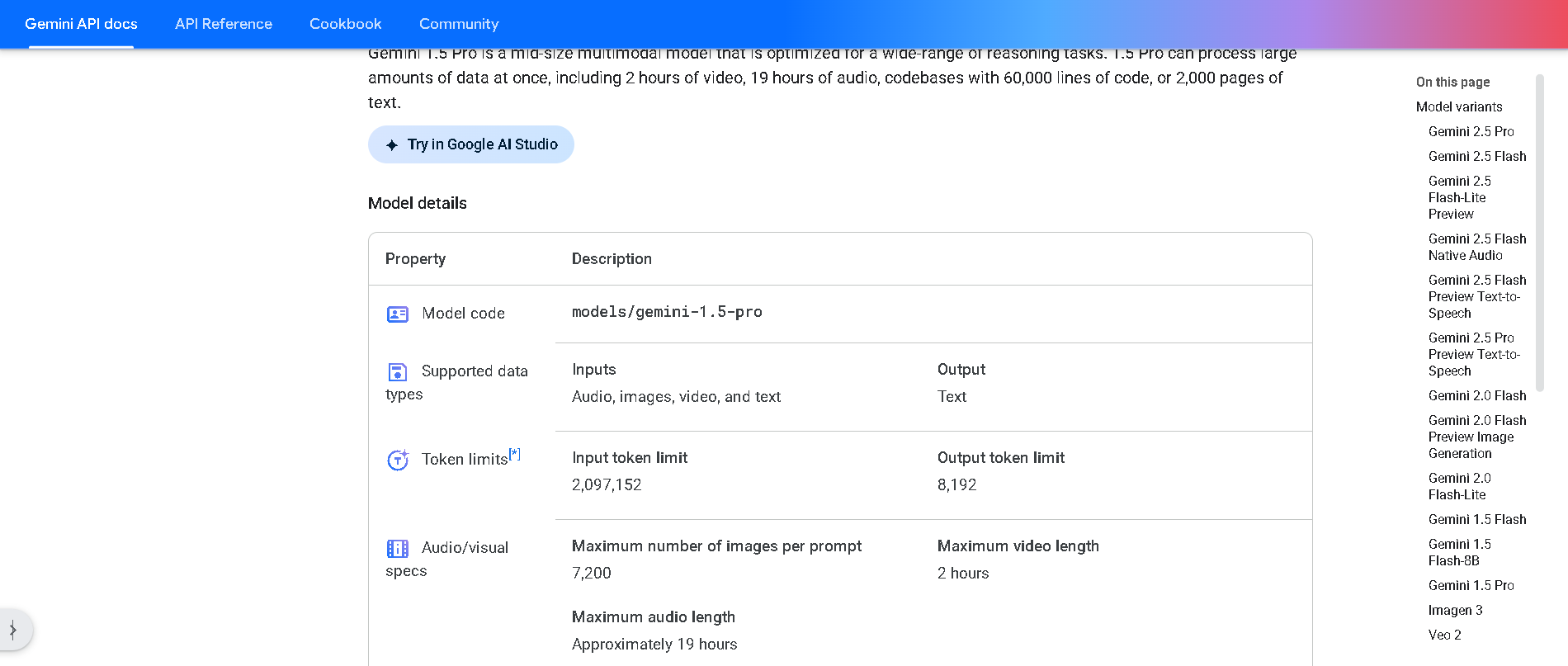
- Developers & Engineers: Analyze large codebases, run data pipelines, build multimodal apps with long-context logic.
- Researchers & Analysts: Summarize big reports, process hours of video/audio, extract insights from large documents.
- Enterprise App Builders: Integrate with Vertex AI and Gemini API for scalable, multimodal intelligence.
- Content & Media Teams: Generate summaries, transcriptions, translations, and visuals at scale.
- AI Students & Enthusiasts: Experiment with long-context reasoning, multimodal inputs, and in-context learning without full model size.
How to Use Gemini 1.5 Pro?
- Access the Model: Available in private preview via Google AI Studio and Vertex AI under the ID `gemini-1.5-pro`.
- Submit Multimodal Inputs: Upload text, code, images, audio, or video—up to 1 million tokens.
- Leverage Long Context: Analyze large files like PDFs, code repos, or hour-long media content in one prompt.
- Enable In-Context Learning: Teach the model new tasks mid-session via example inputs—no tuning required.
- Use Enterprise API Features: Supports grounding (Google Search), JSON mode, function calling, caching, and adjustable safety.
- 1 Million Token Context: Processes up to 700K words, codebases, videos, or datasets in one prompt.
- Mixture-of-Experts (MoE): Intelligent routing boosts efficiency and performance relative to dense models.
- Robust Multimodality: Handles text, image, audio, video, and code in a unified model.
- In-Context Learning: Adapts to new tasks via prompt examples (e.g., low-resource translation) without retraining.
- Leading Benchmark Results: Outperforms Gemini 1.0 Ultra on 87% of benchmark tasks and shows strong downstream gains.
- Support for massive inputs—text, code, audio, video—within 1 M tokens
- Balanced efficiency via MoE architecture
- Strong performance across reasoning, multimodal, and coding tasks
- In-context learning enables flexible task adaptation
- Enterprise-ready with grounding, function-calling, and safety controls
- Still in preview, not yet generally available
- Performance may dip beyond ~200K tokens—preview builds may lag
- Depth over speed—longest-context use cases may incur latency
Free
$ 0.00
API
Custom
- Input Price: 1) $1.25, prompts <= 128k tokens 2) $2.5, prompts > 128k tokens
- Output Price: 1) $5, prompts <= 128k tokens 2) $10, prompts > 128k tokens
- Context Caching Price: 1) $0.3125, prompts <= 128k tokens 2) $0.625, prompts > 128k tokens
- Context caching storage: $4.50 per hour
- Tuning Price: Not available
- Grounding with Google search: $35 / 1K grounding requests
Proud of the love you're getting? Show off your AI Toolbook reviews—then invite more fans to share the love and build your credibility.
Add an AI Toolbook badge to your site—an easy way to drive followers, showcase updates, and collect reviews. It's like a mini 24/7 billboard for your AI.
Reviews
Rating Distribution
Average score
Popular Mention
FAQs
Similar AI Tools
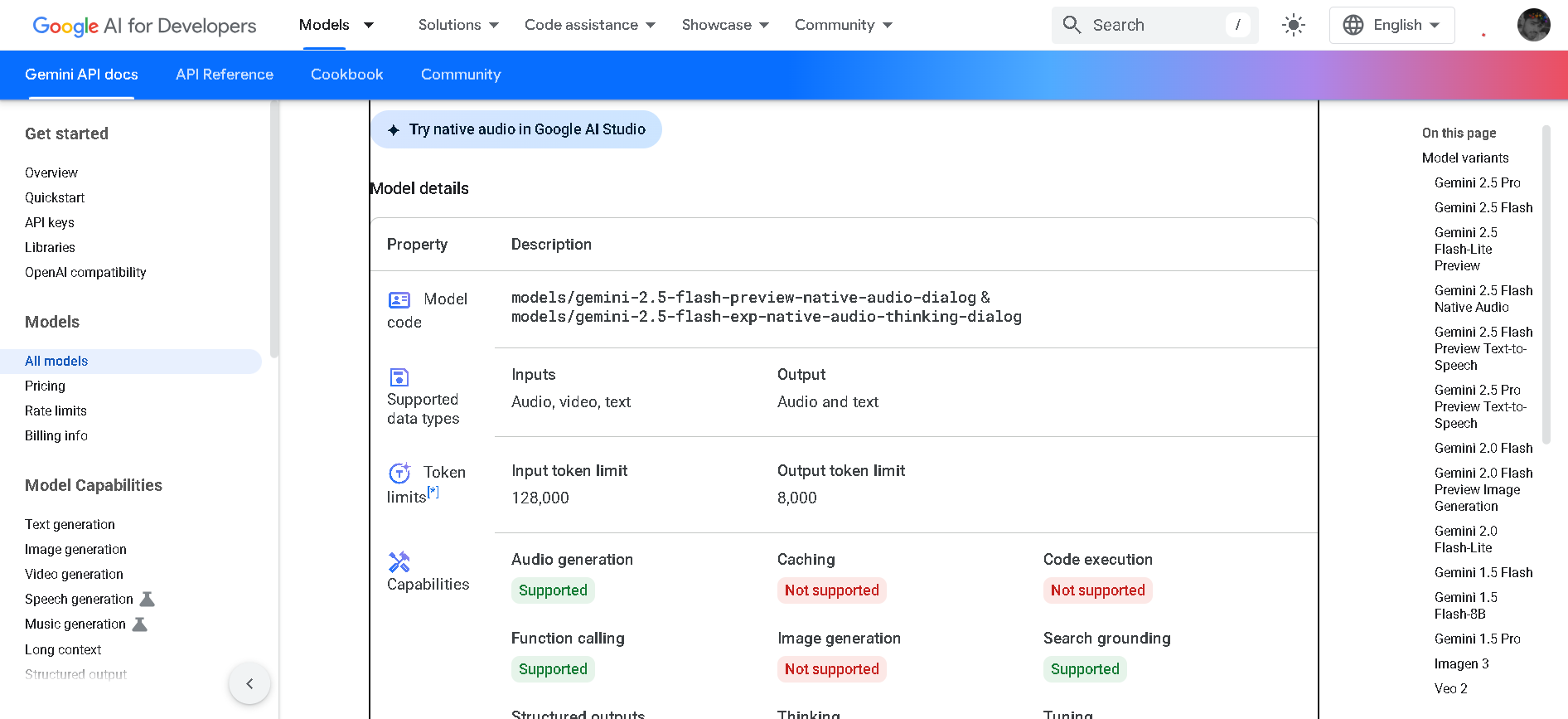
Gemini 2.5 Flash Native Audio is a preview variant of Google DeepMind’s fast, reasoning-enabled “Flash” model, enhanced to support natural, expressive audio dialogue. It allows real-time back-and-forth voice conversation—responding to tone, background noise, affect, and multilingual input—while maintaining its high-speed, multimodal, hybrid-reasoning capabilities.


Gemini 2.5 Flash N..
Gemini 2.5 Flash Native Audio is a preview variant of Google DeepMind’s fast, reasoning-enabled “Flash” model, enhanced to support natural, expressive audio dialogue. It allows real-time back-and-forth voice conversation—responding to tone, background noise, affect, and multilingual input—while maintaining its high-speed, multimodal, hybrid-reasoning capabilities.


Gemini 2.5 Flash N..
Gemini 2.5 Flash Native Audio is a preview variant of Google DeepMind’s fast, reasoning-enabled “Flash” model, enhanced to support natural, expressive audio dialogue. It allows real-time back-and-forth voice conversation—responding to tone, background noise, affect, and multilingual input—while maintaining its high-speed, multimodal, hybrid-reasoning capabilities.
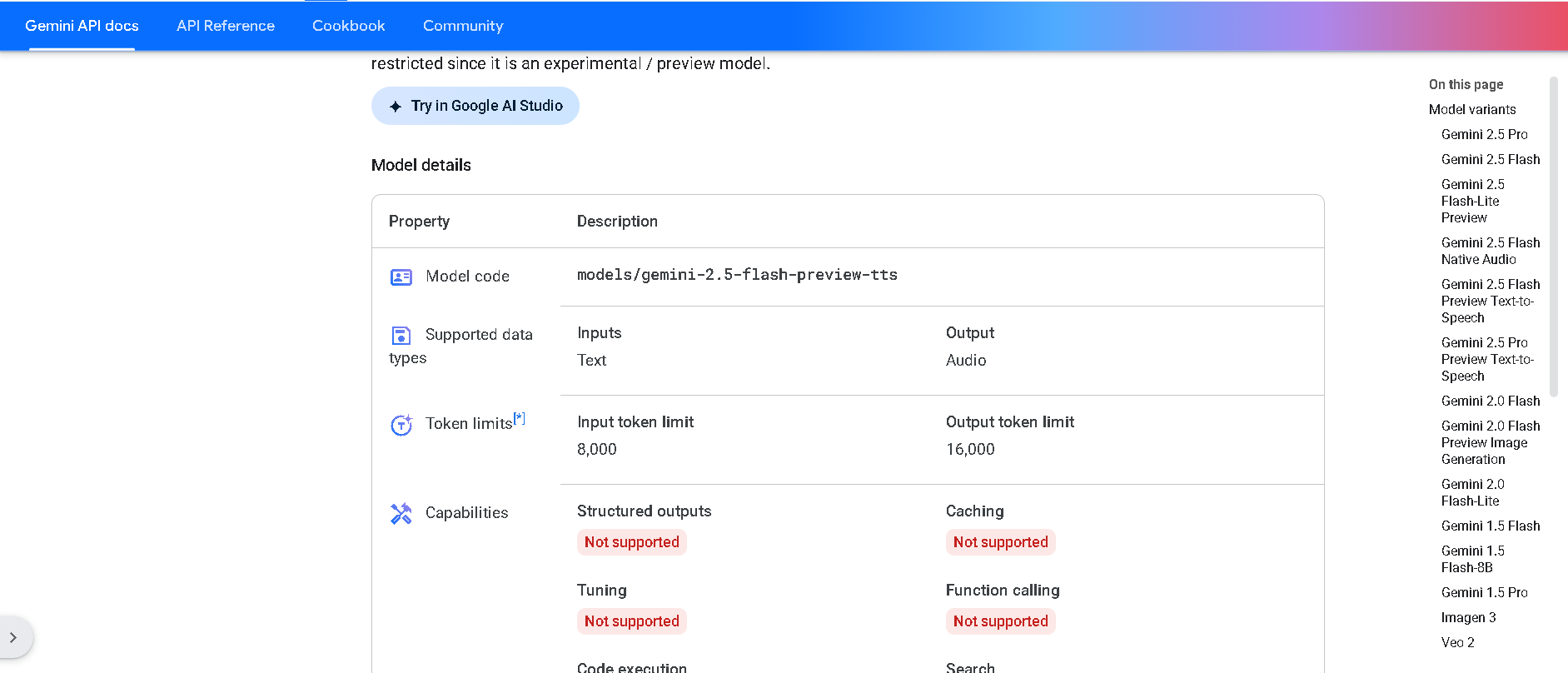

Gemini 2.5 Flash P..
Gemini 2.5 Flash Preview TTS is Google DeepMind’s cutting-edge text-to-speech model that converts text into natural, expressive audio. It supports both single-speaker and multi-speaker output, allowing fine-grained control over style, emotion, pace, and tone. This preview variant is optimized for low latency and structured use cases like podcasts, audiobooks, and customer support workflows .


Gemini 2.5 Flash P..
Gemini 2.5 Flash Preview TTS is Google DeepMind’s cutting-edge text-to-speech model that converts text into natural, expressive audio. It supports both single-speaker and multi-speaker output, allowing fine-grained control over style, emotion, pace, and tone. This preview variant is optimized for low latency and structured use cases like podcasts, audiobooks, and customer support workflows .


Gemini 2.5 Flash P..
Gemini 2.5 Flash Preview TTS is Google DeepMind’s cutting-edge text-to-speech model that converts text into natural, expressive audio. It supports both single-speaker and multi-speaker output, allowing fine-grained control over style, emotion, pace, and tone. This preview variant is optimized for low latency and structured use cases like podcasts, audiobooks, and customer support workflows .
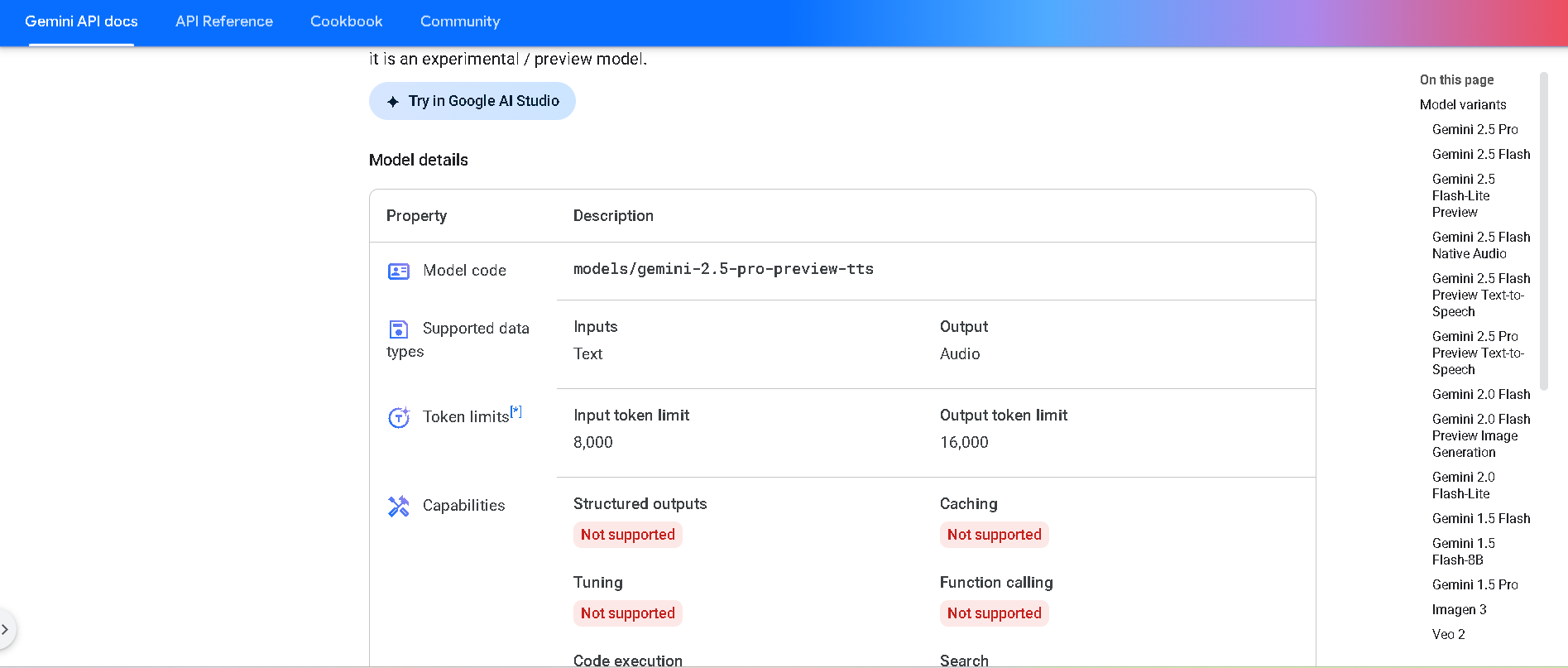

Gemini 2.5 Pro Pre..
Gemini 2.5 Pro Preview TTS is Google DeepMind’s most powerful text-to-speech model in the Gemini 2.5 series, available in preview. It generates natural-sounding audio—from single-speaker readings to multi-speaker dialogue—while offering fine-grained control over voice style, emotion, pacing, and cadence. Designed for high-fidelity podcasts, audiobooks, and professional voice workflows.


Gemini 2.5 Pro Pre..
Gemini 2.5 Pro Preview TTS is Google DeepMind’s most powerful text-to-speech model in the Gemini 2.5 series, available in preview. It generates natural-sounding audio—from single-speaker readings to multi-speaker dialogue—while offering fine-grained control over voice style, emotion, pacing, and cadence. Designed for high-fidelity podcasts, audiobooks, and professional voice workflows.


Gemini 2.5 Pro Pre..
Gemini 2.5 Pro Preview TTS is Google DeepMind’s most powerful text-to-speech model in the Gemini 2.5 series, available in preview. It generates natural-sounding audio—from single-speaker readings to multi-speaker dialogue—while offering fine-grained control over voice style, emotion, pacing, and cadence. Designed for high-fidelity podcasts, audiobooks, and professional voice workflows.
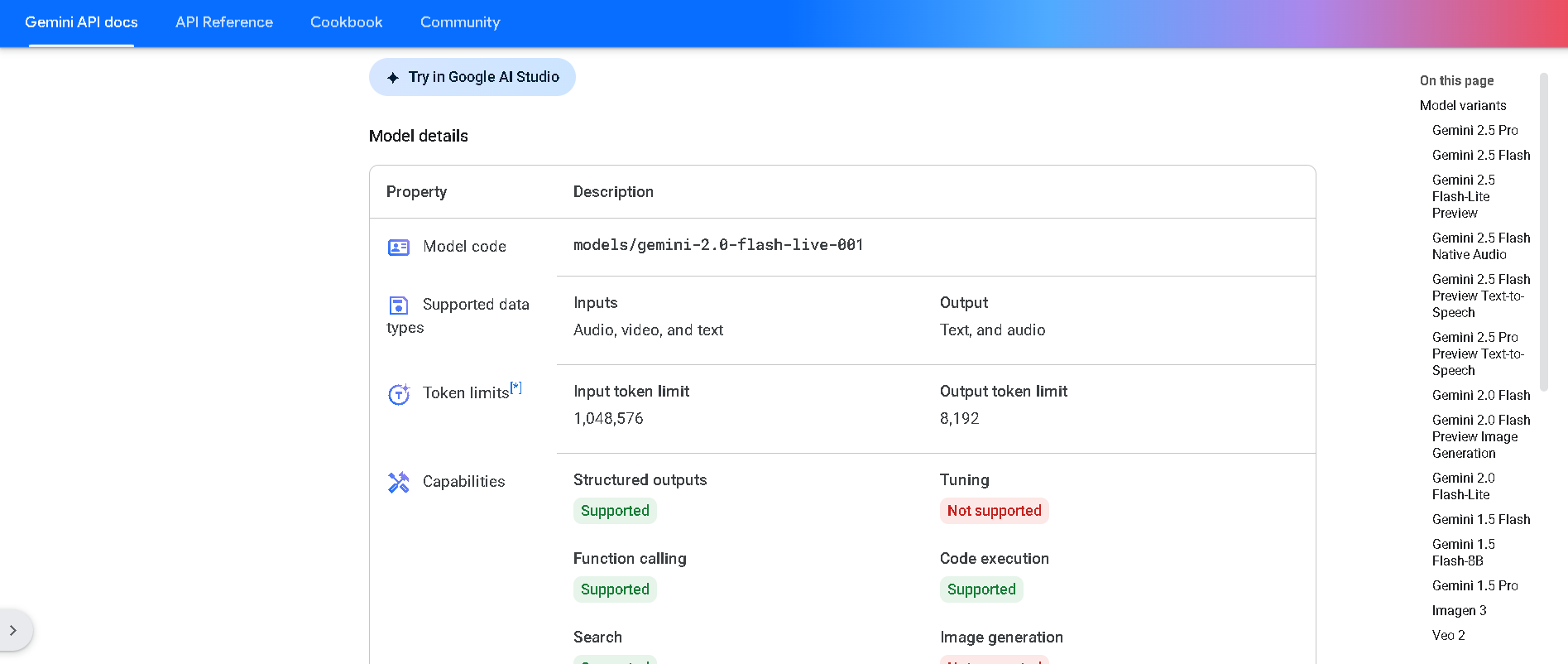

Gemini 2.0 Flash L..
Gemini 2.0 Flash Live is Google DeepMind’s real-time, multimodal chatbot variant powered by the Live API. It supports simultaneous streaming of voice, video, and text inputs, and responds in both spoken audio and text, enabling rich, bidirectional live interactions with low latency and tool integration.


Gemini 2.0 Flash L..
Gemini 2.0 Flash Live is Google DeepMind’s real-time, multimodal chatbot variant powered by the Live API. It supports simultaneous streaming of voice, video, and text inputs, and responds in both spoken audio and text, enabling rich, bidirectional live interactions with low latency and tool integration.


Gemini 2.0 Flash L..
Gemini 2.0 Flash Live is Google DeepMind’s real-time, multimodal chatbot variant powered by the Live API. It supports simultaneous streaming of voice, video, and text inputs, and responds in both spoken audio and text, enabling rich, bidirectional live interactions with low latency and tool integration.
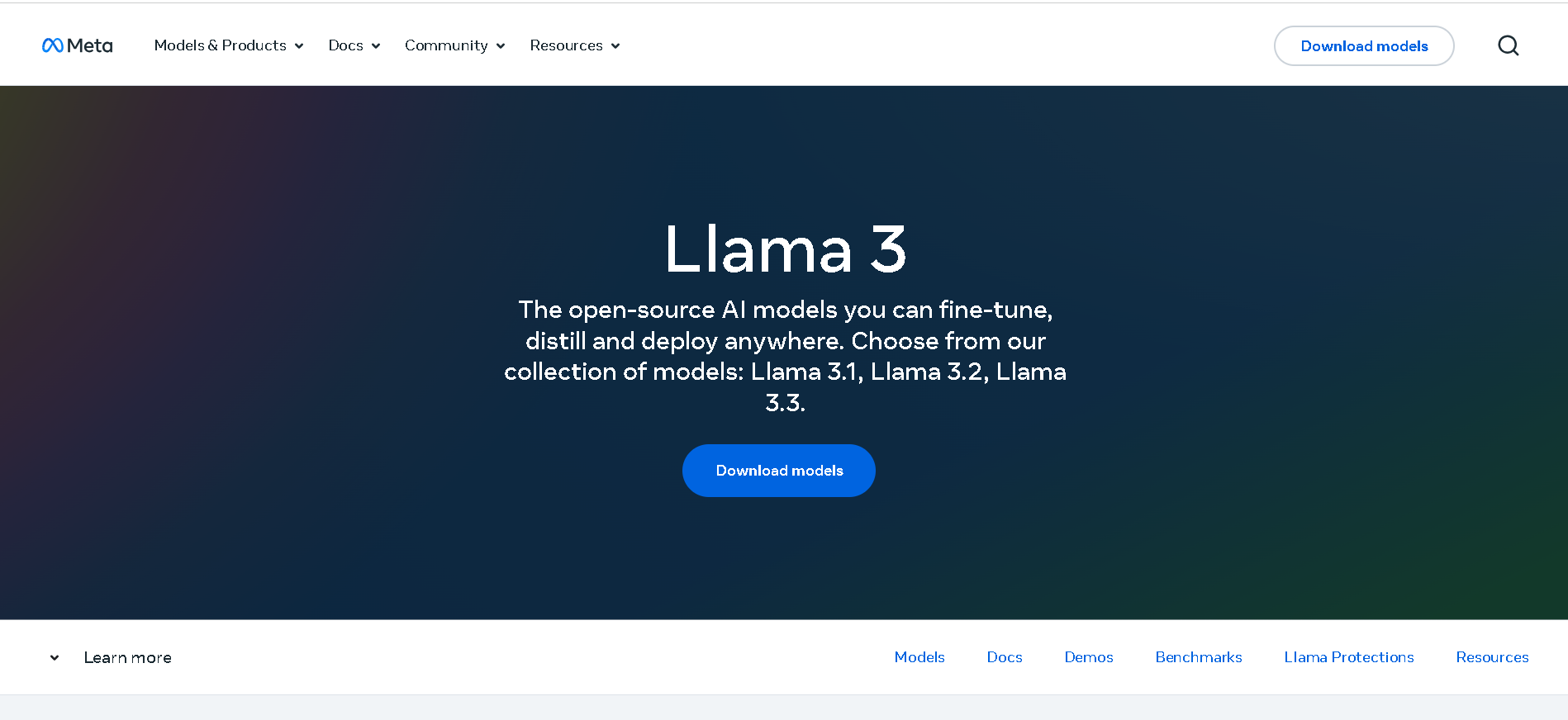

Meta Llama 3
Meta Llama 3 is Meta’s third-generation open-weight large language model family, released in April 2024 and enhanced in July 2024 with the 3.1 update. It spans three sizes—8B, 70B, and 405B parameters—each offering a 128K‑token context window. Llama 3 excels at reasoning, code generation, multilingual text, and instruction-following, and introduces multimodal vision (image understanding) capabilities in its 3.2 series. Robust safety mechanisms like Llama Guard 3, Code Shield, and CyberSec Eval 2 ensure responsible output.


Meta Llama 3
Meta Llama 3 is Meta’s third-generation open-weight large language model family, released in April 2024 and enhanced in July 2024 with the 3.1 update. It spans three sizes—8B, 70B, and 405B parameters—each offering a 128K‑token context window. Llama 3 excels at reasoning, code generation, multilingual text, and instruction-following, and introduces multimodal vision (image understanding) capabilities in its 3.2 series. Robust safety mechanisms like Llama Guard 3, Code Shield, and CyberSec Eval 2 ensure responsible output.


Meta Llama 3
Meta Llama 3 is Meta’s third-generation open-weight large language model family, released in April 2024 and enhanced in July 2024 with the 3.1 update. It spans three sizes—8B, 70B, and 405B parameters—each offering a 128K‑token context window. Llama 3 excels at reasoning, code generation, multilingual text, and instruction-following, and introduces multimodal vision (image understanding) capabilities in its 3.2 series. Robust safety mechanisms like Llama Guard 3, Code Shield, and CyberSec Eval 2 ensure responsible output.
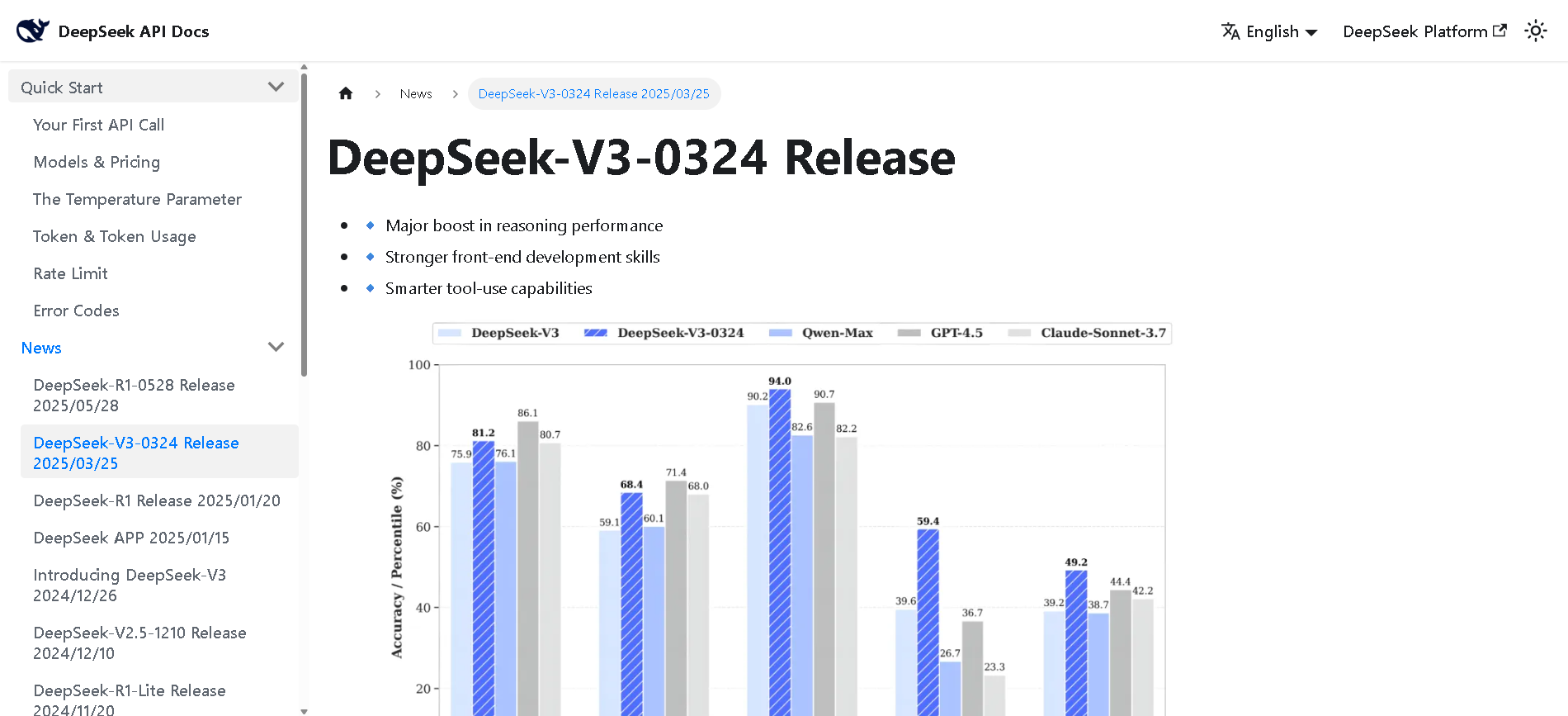

DeepSeek-V3-0324
DeepSeek V3 (0324) is the latest open-source Mixture-of-Experts (MoE) language model from DeepSeek, featuring 671B parameters (37B active per token). Released in March 2025 under the MIT license, it builds on DeepSeek V3 with major enhancements in reasoning, coding, front-end generation, and Chinese proficiency. It maintains cost-efficiency and function-calling support.


DeepSeek-V3-0324
DeepSeek V3 (0324) is the latest open-source Mixture-of-Experts (MoE) language model from DeepSeek, featuring 671B parameters (37B active per token). Released in March 2025 under the MIT license, it builds on DeepSeek V3 with major enhancements in reasoning, coding, front-end generation, and Chinese proficiency. It maintains cost-efficiency and function-calling support.


DeepSeek-V3-0324
DeepSeek V3 (0324) is the latest open-source Mixture-of-Experts (MoE) language model from DeepSeek, featuring 671B parameters (37B active per token). Released in March 2025 under the MIT license, it builds on DeepSeek V3 with major enhancements in reasoning, coding, front-end generation, and Chinese proficiency. It maintains cost-efficiency and function-calling support.
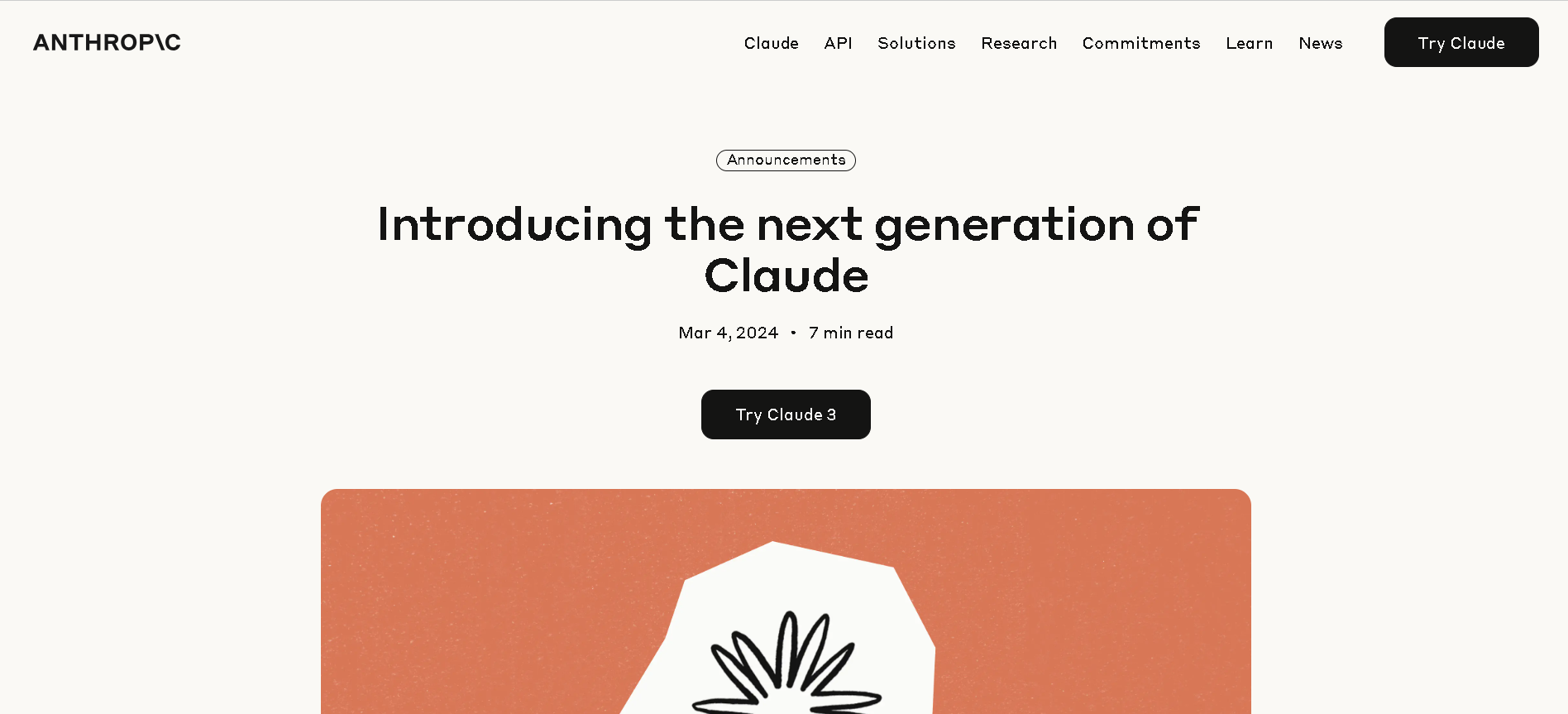

Claude 3 Opus
Claude 3 Opus is Anthropic’s flagship Claude 3 model, released March 4, 2024. It offers top-tier performance for deep reasoning, complex code, advanced math, and multimodal understanding—including charts and documents—supported by a 200K‑token context window (extendable to 1 million in select enterprise cases). It consistently outperforms GPT‑4 and Gemini Ultra on benchmark tests like MMLU, HumanEval, HellaSwag, and more.


Claude 3 Opus
Claude 3 Opus is Anthropic’s flagship Claude 3 model, released March 4, 2024. It offers top-tier performance for deep reasoning, complex code, advanced math, and multimodal understanding—including charts and documents—supported by a 200K‑token context window (extendable to 1 million in select enterprise cases). It consistently outperforms GPT‑4 and Gemini Ultra on benchmark tests like MMLU, HumanEval, HellaSwag, and more.


Claude 3 Opus
Claude 3 Opus is Anthropic’s flagship Claude 3 model, released March 4, 2024. It offers top-tier performance for deep reasoning, complex code, advanced math, and multimodal understanding—including charts and documents—supported by a 200K‑token context window (extendable to 1 million in select enterprise cases). It consistently outperforms GPT‑4 and Gemini Ultra on benchmark tests like MMLU, HumanEval, HellaSwag, and more.
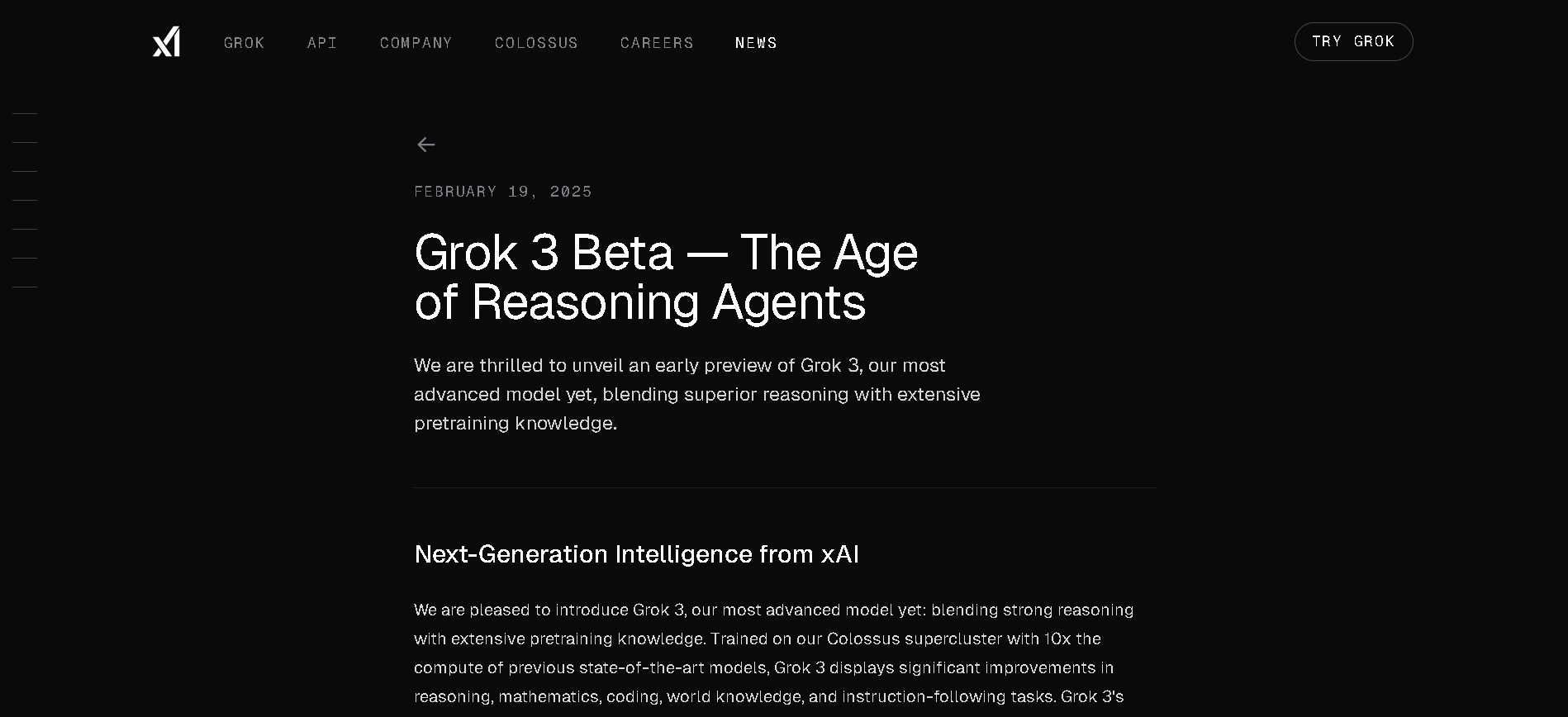
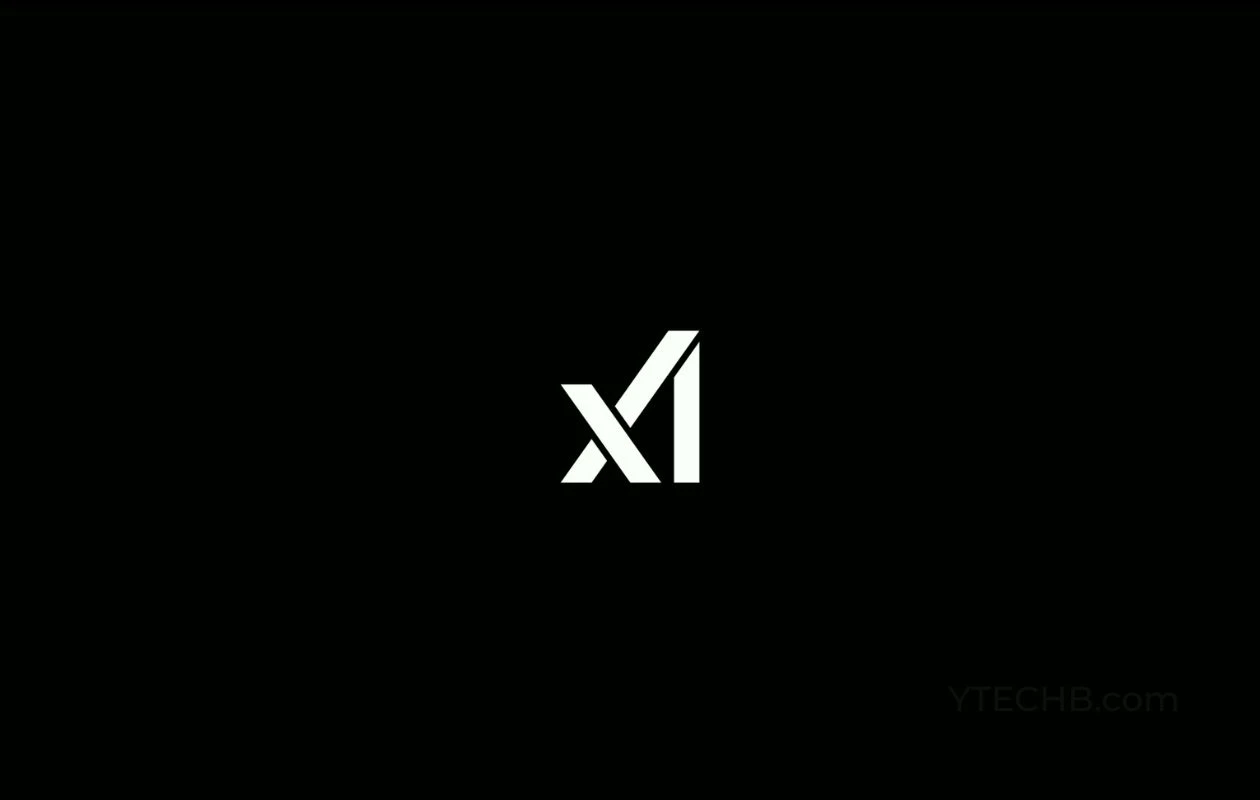
Grok 3 Latest
Grok 3 is xAI’s newest flagship AI chatbot, released on February 17, 2025, running on the massive Colossus supercluster (~200,000 GPUs). It offers elite-level reasoning, chain-of-thought transparency (“Think” mode), advanced “Big Brain” deeper reasoning, multimodal support (text, images), and integrated real-time DeepSearch—positioning it as a top-tier competitor to GPT‑4o, Gemini, Claude, and DeepSeek V3 on benchmarks.


Grok 3 Latest
Grok 3 is xAI’s newest flagship AI chatbot, released on February 17, 2025, running on the massive Colossus supercluster (~200,000 GPUs). It offers elite-level reasoning, chain-of-thought transparency (“Think” mode), advanced “Big Brain” deeper reasoning, multimodal support (text, images), and integrated real-time DeepSearch—positioning it as a top-tier competitor to GPT‑4o, Gemini, Claude, and DeepSeek V3 on benchmarks.


Grok 3 Latest
Grok 3 is xAI’s newest flagship AI chatbot, released on February 17, 2025, running on the massive Colossus supercluster (~200,000 GPUs). It offers elite-level reasoning, chain-of-thought transparency (“Think” mode), advanced “Big Brain” deeper reasoning, multimodal support (text, images), and integrated real-time DeepSearch—positioning it as a top-tier competitor to GPT‑4o, Gemini, Claude, and DeepSeek V3 on benchmarks.
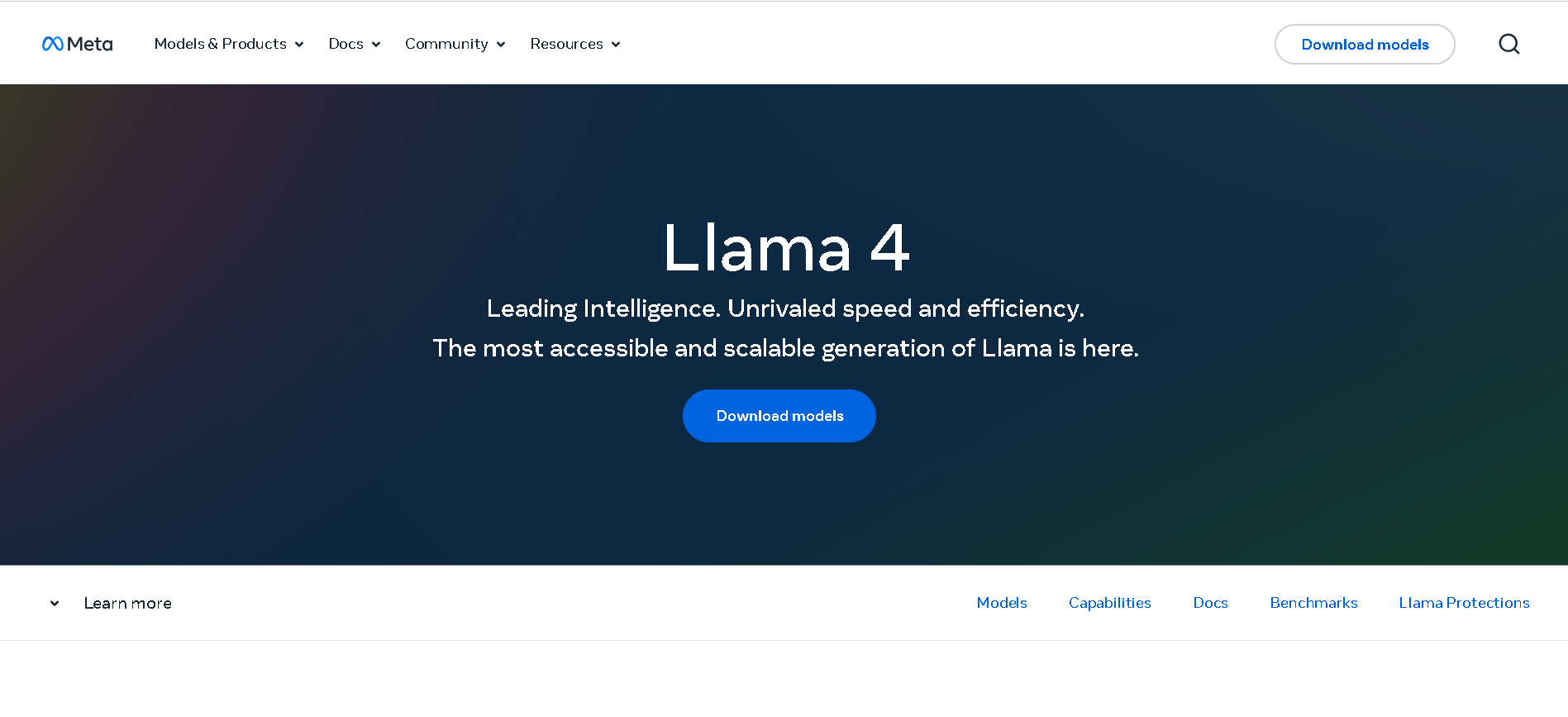

Meta Llama 4 Scout
Llama 4 Scout is Meta’s compact and high-performance entry in the Llama 4 family, released April 5, 2025. Built on a mixture-of-experts (MoE) architecture with 17B active parameters (109B total) and a staggering 10‑million-token context window, it delivers top-tier speed and long-context reasoning while fitting on a single Nvidia H100 GPU. It outperforms models like Google's Gemma 3, Gemini 2.0 Flash‑Lite, and Mistral 3.1 across benchmarks.


Meta Llama 4 Scout
Llama 4 Scout is Meta’s compact and high-performance entry in the Llama 4 family, released April 5, 2025. Built on a mixture-of-experts (MoE) architecture with 17B active parameters (109B total) and a staggering 10‑million-token context window, it delivers top-tier speed and long-context reasoning while fitting on a single Nvidia H100 GPU. It outperforms models like Google's Gemma 3, Gemini 2.0 Flash‑Lite, and Mistral 3.1 across benchmarks.


Meta Llama 4 Scout
Llama 4 Scout is Meta’s compact and high-performance entry in the Llama 4 family, released April 5, 2025. Built on a mixture-of-experts (MoE) architecture with 17B active parameters (109B total) and a staggering 10‑million-token context window, it delivers top-tier speed and long-context reasoning while fitting on a single Nvidia H100 GPU. It outperforms models like Google's Gemma 3, Gemini 2.0 Flash‑Lite, and Mistral 3.1 across benchmarks.
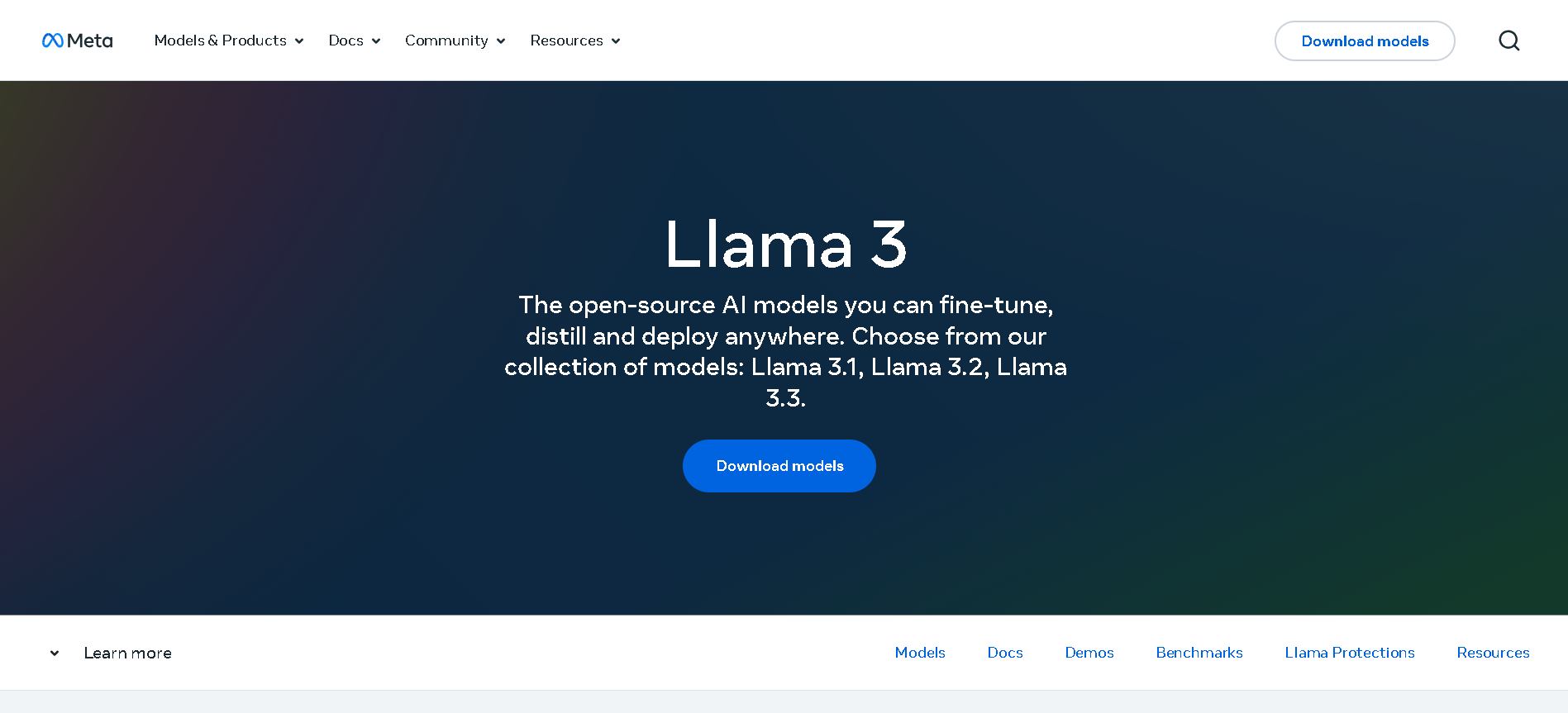

Meta Llama 3.2
Llama 3.2 is Meta’s multimodal and lightweight update to its Llama 3 line, released on September 25, 2024. The family includes 1B and 3B text-only models optimized for edge devices, as well as 11B and 90B Vision models capable of image understanding. It offers a 128K-token context window, Grouped-Query Attention for efficient inference, and opens up on-device, private AI with strong multilingual (e.g. Hindi, Spanish) support.


Meta Llama 3.2
Llama 3.2 is Meta’s multimodal and lightweight update to its Llama 3 line, released on September 25, 2024. The family includes 1B and 3B text-only models optimized for edge devices, as well as 11B and 90B Vision models capable of image understanding. It offers a 128K-token context window, Grouped-Query Attention for efficient inference, and opens up on-device, private AI with strong multilingual (e.g. Hindi, Spanish) support.


Meta Llama 3.2
Llama 3.2 is Meta’s multimodal and lightweight update to its Llama 3 line, released on September 25, 2024. The family includes 1B and 3B text-only models optimized for edge devices, as well as 11B and 90B Vision models capable of image understanding. It offers a 128K-token context window, Grouped-Query Attention for efficient inference, and opens up on-device, private AI with strong multilingual (e.g. Hindi, Spanish) support.
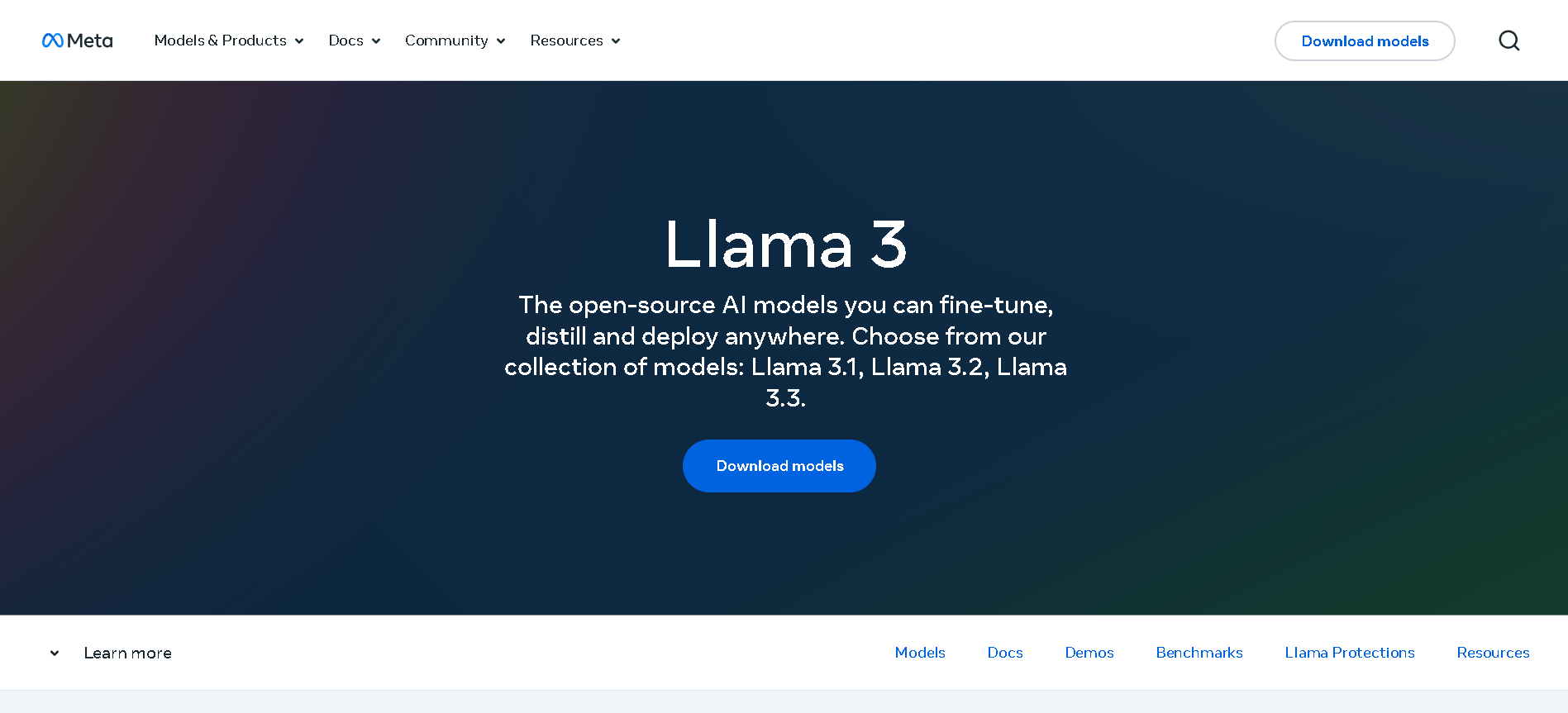

Meta Llama 3.3
Llama 3.3 is Meta’s instruction-tuned, text-only large language model released on December 6, 2024, available in a 70B-parameter size. It matches the performance of much larger models using significantly fewer parameters, is multilingual across eight key languages, and supports a massive 128,000-token context window—ideal for handling long-form documents, codebases, and detailed reasoning tasks.


Meta Llama 3.3
Llama 3.3 is Meta’s instruction-tuned, text-only large language model released on December 6, 2024, available in a 70B-parameter size. It matches the performance of much larger models using significantly fewer parameters, is multilingual across eight key languages, and supports a massive 128,000-token context window—ideal for handling long-form documents, codebases, and detailed reasoning tasks.


Meta Llama 3.3
Llama 3.3 is Meta’s instruction-tuned, text-only large language model released on December 6, 2024, available in a 70B-parameter size. It matches the performance of much larger models using significantly fewer parameters, is multilingual across eight key languages, and supports a massive 128,000-token context window—ideal for handling long-form documents, codebases, and detailed reasoning tasks.
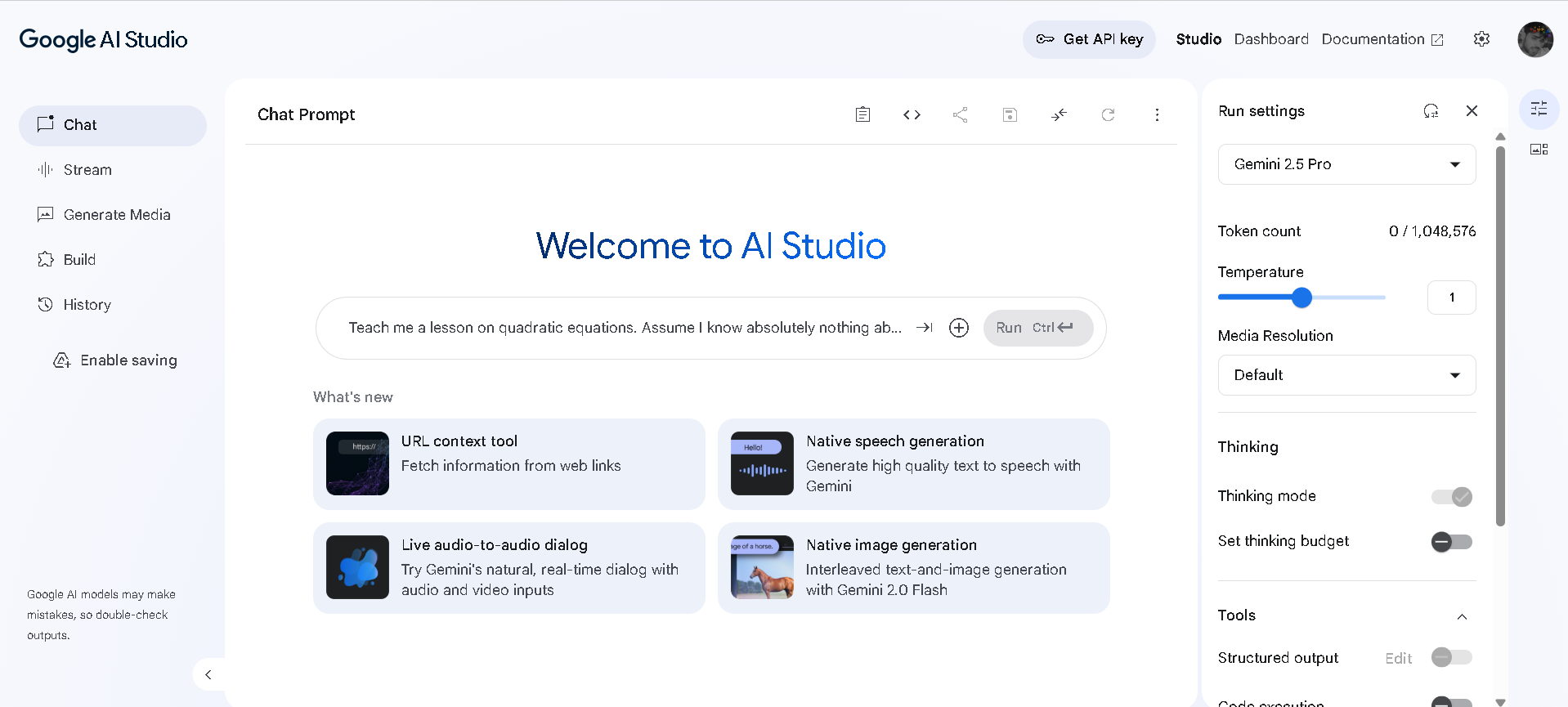

Google AI Studio
Google AI Studio is a web-based development environment that allows users to explore, prototype, and build applications using Google's cutting-edge generative AI models, such as Gemini. It provides a comprehensive set of tools for interacting with AI through chat prompts, generating various media types, and fine-tuning model behaviors for specific use cases.


Google AI Studio
Google AI Studio is a web-based development environment that allows users to explore, prototype, and build applications using Google's cutting-edge generative AI models, such as Gemini. It provides a comprehensive set of tools for interacting with AI through chat prompts, generating various media types, and fine-tuning model behaviors for specific use cases.


Google AI Studio
Google AI Studio is a web-based development environment that allows users to explore, prototype, and build applications using Google's cutting-edge generative AI models, such as Gemini. It provides a comprehensive set of tools for interacting with AI through chat prompts, generating various media types, and fine-tuning model behaviors for specific use cases.
Editorial Note
This page was researched and written by the ATB Editorial Team. Our team researches each AI tool by reviewing its official website, testing features, exploring real use cases, and considering user feedback. Every page is fact-checked and regularly updated to ensure the information stays accurate, neutral, and useful for our readers.
If you have any suggestions or questions, email us at hello@aitoolbook.ai
